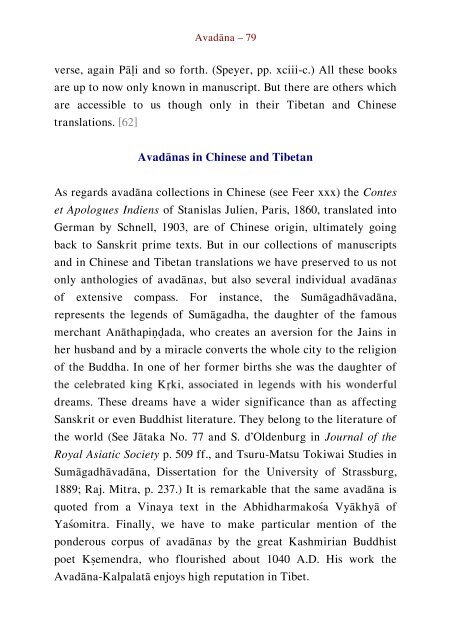Literary History of Sanskrit Buddhism
A study by J. K. Nariman of Sanskrit Buddhism from the Early Buddhist Tradition up to the Mahayana texts proper.
A study by J. K. Nariman of Sanskrit Buddhism from the Early Buddhist Tradition up to the Mahayana texts proper.
You also want an ePaper? Increase the reach of your titles
YUMPU automatically turns print PDFs into web optimized ePapers that Google loves.
Avadāna – 79<br />
verse, again Pāḷi and so forth. (Speyer, pp. xciii-c.) All these books<br />
are up to now only known in manuscript. But there are others which<br />
are accessible to us though only in their Tibetan and Chinese<br />
translations. [62]<br />
Avadānas in Chinese and Tibetan<br />
As regards avadāna collections in Chinese (see Feer xxx) the Contes<br />
et Apologues Indiens <strong>of</strong> Stanislas Julien, Paris, 1860, translated into<br />
German by Schnell, 1903, are <strong>of</strong> Chinese origin, ultimately going<br />
back to <strong>Sanskrit</strong> prime texts. But in our collections <strong>of</strong> manuscripts<br />
and in Chinese and Tibetan translations we have preserved to us not<br />
only anthologies <strong>of</strong> avadānas, but also several individual avadānas<br />
<strong>of</strong> extensive compass. For instance, the Sumāgadhāvadāna,<br />
represents the legends <strong>of</strong> Sumāgadha, the daughter <strong>of</strong> the famous<br />
merchant Anāthapiṇḍada, who creates an aversion for the Jains in<br />
her husband and by a miracle converts the whole city to the religion<br />
<strong>of</strong> the Buddha. In one <strong>of</strong> her former births she was the daughter <strong>of</strong><br />
dreams. These dreams have a wider significance than as affecting<br />
<strong>Sanskrit</strong> or even Buddhist literature. They belong to the literature <strong>of</strong><br />
the world (See Jātaka No. 77 and S. d’Oldenburg in Journal <strong>of</strong> the<br />
Royal Asiatic Society p. 509 ff., and Tsuru-Matsu Tokiwai Studies in<br />
Sumāgadhāvadāna, Dissertation for the University <strong>of</strong> Strassburg,<br />
1889; Raj. Mitra, p. 237.) It is remarkable that the same avadāna is<br />
quoted from a Vinaya text in the Abhidharmakośa Vyākhyā <strong>of</strong><br />
Yaśomitra. Finally, we have to make particular mention <strong>of</strong> the<br />
ponderous corpus <strong>of</strong> avadānas by the great Kashmirian Buddhist<br />
poet Kṣemendra, who flourished about 1040 A.D. His work the<br />
Avadāna-Kalpalatā enjoys high reputation in Tibet.


















